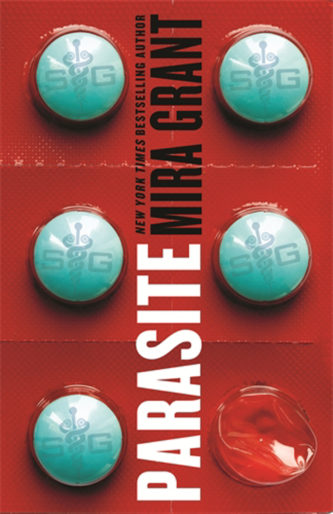By MIRA GRANT (Orbit; 2013)
This novel, the first in Mira Grant’s “Parasitology” trilogy, PARASITE boasts a riveting Cronenbergian premise and is a definite page-turner (and has a very striking cover design). Unfortunately it falls short in most every other respect.
…a riveting Cronenbergian premise and is a definite page-turner…
The time is 2027. Disease has been eradicated due to a specially designed tapeworm that much of humanity has voluntarily ingested. The source of this “Intestinal Bodyguard” is the SymboGen Corporation, whose cofounder and creator of the parasite, one Dr. Steven Banks, takes pains to assure the world that the tapeworm is safe. But as you’ve probably guessed, that’s just not the case.
Disease has been eradicated due to a specially designed tapeworm that much of humanity has voluntarily ingested.
The story is told from the point of view of Sally Mitchell, a young woman who died in a car accident only to come back to life, apparently due to her SymboGen parasite. Sally has no memory of her former life, suggesting that her tapeworm has had a far greater influence on her psyche than was initially apparent, and leading to a none-too-surprising “surprise” ending.
But before that people begin coming down with a strange condition that turns them into walking zombies. Clearly the parasites have something to do with this fast-spreading epidemic. Sally, together with her parasitologist BF Nathan and a plucky dog bequeathed by one of the zombified unfortunates, is determined to get to the bottom of the madness. This entails an investigation of SymboGen, which is of course doing everything it can to downplay the zombie contagion and its implications.
This book’s problems start with its premise, which as stated above is tremendous, but is never sufficiently developed. Just how SymboGen manages to convince much of the world to ingest tapeworms is never explained, and nor do we ever get any sense of precisely how such a world would function (the legal ramifications of widespread tapeworm implantation would be substantial, I’d think, as would the competition from rival firms).
This book’s problems start with its premise, which as stated above is tremendous, but is never sufficiently developed.
Perhaps those issues will be explored in the subsequent Parasitology volumes, but I’m surprised they weren’t brought up here; given PARASITE’S decidedly excessive 500-plus page length, it’s not like there wasn’t enough space.

